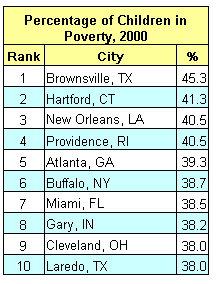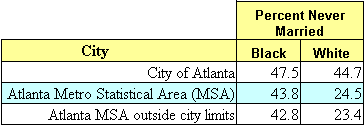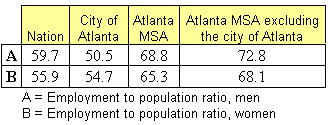
Issue 154 - October 13 2005
Black Mecca: The Death of an Illusion
Atlanta Leads Nation in Child Poverty
By Bruce A. Dixon, BC Associate Editor
Printer Friendly Version
Note: The size of the type may be changed by clicking on view at the top of your browser and selecting "text size". The document will print in the size you select.
It was the place to be, we were told throughout the Eighties and Nineties. The housing was cheap, the weather benign, the social and business networks poppin’, the elected officials black and enlightened, and the opportunities limitless. Twenty years before it had been “the city too busy to hate.” Now it was the “Black Mecca,” and pilgrims streamed in by the tens of thousands each year.
Maynard Jackson was elected Atlanta’s first black mayor in 1973, only 5 years after the death of Dr. Martin Luther King. According to a June 29, 2003 Atlanta Journal-Constitution article by Ernie Suggs:
“In 1973, fewer than 1 percent of the city's contracts went to minorities. Five years later, it was 38.6 percent. At one point, more than 80 percent of all minority contracts at U.S. airports were in Atlanta, prompting Jackson once to boast that he had helped create 25 new black millionaires….”
Those first 25 millionaires, with the assistance of the next three black Atlanta mayors, have helped to create scores of additional black millionaires along with the thriving, empowered, well-connected and ambitious business and professional class which identifies with the people who run Atlanta to this day.
”Metro Atlanta is emerging as the new heart of the nation's black middle class,” proclaimed the Atlanta Journal-Constitution on September 25, 2002. ”’Atlanta has become… a modern-day Harlem, a place of opportunity where educated blacks can enjoy the fruits of the post civil rights era economy,’ said Roderick Harrison, a demographer with the Joint Center for Political and Economic Studies, an African-American think tank in Washington.”
But despite Atlanta being home to more local black-owned companies per-capita than anywhere except the nation’s capital, for almost half of black Atlanta’s children “Black Mecca” never happened at all. As far back as 1998, two years after the Olympics when the hype was at its heaviest, the Associated Press reported that 35% of black Atlanta was below the poverty level. By the year 2000, child poverty in Atlanta was 5th in the nation, ranking only 6 points behind Brownsville TX, a single percentage point behind New Orleans, and one ahead of Gary and Cleveland.

And now, census data show the city of Atlanta leads the nation in child poverty by a narrow margin.

The contradiction between more than 20 years of Atlanta’s leading the nation in the creation of black millionaires while the majority black and proudly black-ruled city also leads the nation in the percentage of its children in poverty starkly exposes the moral and civic bankruptcy of black leadership not just in Atlanta, but throughout black America.
Prophetic Leadership, Or Profitable Leadership?
In 1968, when black sanitation workers in Memphis, Tennessee went on strike for safer working conditions, decent wages and the right to have their union recognized, black ministers urged their congregations to march at the side of strikers. The NAACP followed suit. After Dr. Martin Luther King, Jr. came to town, even the high schools were emptied to join some of the mass marches. The National Guard was mobilized, many arrests were made and Dr. King was murdered. The Memphis sanitation workers ultimately won their union contract, and thousands of ordinary working families in that city got living wages that allowed them to educate their children, buy houses, live decent and dignified lives, and even retire.
Eight years later in Maynard Jackson’s Atlanta, where nurturing of millionaires and the business class took precedence over uplifting the fortunes of ordinary working people, the city’s black mayor rallied white business leaders and the Atlanta Journal-Constitution, and fired more than a thousand city employees to crush a strike that resulted when the mayor refused to honor prior promised pay raises for the black men who picked up the city’s garbage.
The contrast between the prophetic leadership of the civil rights movement era and the profit-oriented leadership of the black business class that came in its wake could not be clearer. Old Testament prophets, like civil and human rights advocates, were not millionaires or kings. They were not in government, nor were they entrepreneurs. They were ordinary people, often reviled and persecuted for daring to speak impolite and unpleasant truths to the powerful and the well connected. Black business people of the old school, the generation of A. G. Gaston and John H. Johnson who heeded the call of the movement’s prophetic leaders rather than trying to pretend that they were leaders themselves, did more to help the movement and advance the fortunes of ordinary African Americans on a bad day than most of the Maynard Jackson millionaires do in their entire careers.
Today’s elite black leadership does not measure cities by their incarceration rates, nor do they measure their own performance by the prevalence or absence of child poverty, affordable health care, equality of access to good education or any of the things that matter to ordinary black families. What matters to these “black leaders” are big-ticket projects, bragging rights, relentless self-promotion, and the accumulation of contacts, contracts and personal wealth. “Black Mecca” was always intended to be where their dreams came true, not ours.
The guiding principles of America’s black business-class leadership are the enrichment of its individual members, and its own self-promotion as folks with the legitimate claim to leadership of African Americans. The “Black Mecca” hype was the product of this relentless business-class self-promotion. For the small subset of African American business and professional people possessing the requisite skills, contacts and access to capital, Atlanta did offer unparalleled opportunities. These have been replicated on a smaller scale in other cities where the previous generation’s movement for human and civil rights forced open some of the doors to governance and contracting.
The black business and political class does what it does well enough. But unlike the black business people of previous generations, it stubbornly refuses to help open up the doors of prosperity to other segments of the black community. The Black business class and their representatives in power don’t know how to liberate anybody – they know how to get paid.
“Black Mecca” No Promised Land for Single Black Female Professionals
For many educated black professionals who migrated to Atlanta, looking for a piece of “black Mecca”, especially women, the results have been decidedly mixed. There is disturbing evidence that nationwide structural imbalances between the numbers and availability of employed black men vs. employed black women, and disparities between numbers of educated and professional black men and women may actually be greater in business-class led black Atlanta than in the rest of black America.
The gender mismatch among the Black professional classes was detailed in a study by Professor J. Vincent Egan, published by Clark Atlanta University’s Southern Center for Studies in Public Policy. In the center’s 2004 “Status of Black Atlanta” report, Egan compared relevant data on marriage, cohabitation, the relative availability, employment and educational status of men and women between African Americans in Atlanta’s city and suburbs, between the metro area and the rest of Georgia and the nation, and concluded that “marriage among blacks is much worse in the city of Atlanta than in the Atlanta metro area and the nation.”
“There has been a large rise in the incidence of never married men and women…a large component of the decline in the marriage rate – especially for African Americans since 1970. Nationally 41.6% of black men and 39.7% of black women…have never been married. In 2002 over 84.5% of black women ages 25-29have never been married, and 50.2% of black women ages 40-44 have never been married. In the city of Atlanta, 46.7% of black males and 48.1% of black females have never been married.”

Egan goes on to examine the impact of the decline in marriage to the lives and fates of men and of children. The latter are at greater risk for contact with the prison industry, and for men, “The most recent study of twins found a marriage premium of 19% that is attributable to marriage itself… For black men however, the marriage premium is the highest of all ethnic groups and was 38% in 1979.”
“On the negative side the decline of marriage has been correlated with labor market performance by black men. Particularly striking has been the growth of idleness (defined as an individual not working all year long) among black men. Based on Current Population Survey data in 2002, 25% of black men in the US were idle, double the rates for white and Hispanic men. Because of the growth in idleness, many economists now prefer to report the employment to population ratio to examine employment issues facing black men (and not simply the unemployment rate or labor force participation). Also the unemployment rate for less educated black females rose significantly in the 1990s while the employment rate for less educated black males continued to decline…in the city of Atlanta, only about half the black men were employed in 2000. The employment/population ratio was higher for black women than black men. This was not true for blacks either in the Atlanta MSA outside the city or nationally.

Egan details the ratios of available men to women in black Atlanta.

For the professional Black woman, finding a man of similar background is especially difficult in Atlanta, says Egan:
“There is also a gap for graduate and professional women. Nationally there are 690 black men with graduate and professional degrees for every 1,000 black women, 663 in the Atlanta MSA, and 710 in the city of Atlanta. The opposite situation exists for whites in the Atlanta MSA. There are 1,019 white men with some college for every 1,000 white women, 1,147 white men with college or better for every 1,000 white women, and 1,252 white men with graduate degrees for every 1,000 white women. In fact, the surplus more than compensates for the black female deficit. There are 8,984 more black women than black men with graduate and professional degrees, but 22,778 more white men than white females. There are 42,589 more white men with college degrees than white females, but 25,443 more black women than black men with college degrees.
“Similar results hold for individuals with managerial and professional jobs. There re 610 black males with managerial and professional jobs for every 1,000 black women in the Atlanta MSA, and 464 in the city of Atlanta.”
Black female professionals want careers, but they deserve the possibility of solid and stable families and communities too. Just as poor and working class African Americans are ill served by our business class black leadership, they are too.
Time for a New Leadership Model
The time is ripe for a new kind of black leadership, and for us to develop new models of urban empowerment and economic development. The black business class has proven itself adept at profiting from the privatization of public services and resources, thus lowering the quality of life in larger African American communities. They have often reaped, and enabled others to reap windfall profits when neighborhoods of poorer, blacker residents were displaced by richer and whiter ones. This kind of leadership costs more than it is worth.
It is time to develop new models of leadership, and new engines of economic development for our black communities, the goals of which must be to develop the human and material resources of the cities for the people who live in them now, not for outsiders they hope to attract, or for the narrow class of “Maynard Jackson millionaires” and their wannabes. Public pension funds and union funds are a good start, and could be used to build some of that housing.
Over the past two years, BC has run a continuing series of articles exploring some aspects of what a plan for urban centers to save themselves might look like. (See BC “Wanted: A Plan for the Cities to Save Themselves,” Parts One, Two, Three, Four and Five.)
The time for pilgrimage is over. The next black Meccas must be built in the many cities where we already stand, and for the people who already live there. This will be part of black America’s unfinished business, to be taken up next spring, in Gary, Indiana.
BC Associate Editor Bruce Dixon can be contacted at [email protected].
![]()
![]()
Your comments are always welcome.
Visit the Contact Us page to send e-Mail or Feedback
or Click here to send e-Mail to [email protected]
If you send us an e-Mail message we may publish all or part of it, unless you tell us it is not for publication. You may also request that we withhold your name.
Thank you very much for your readership.